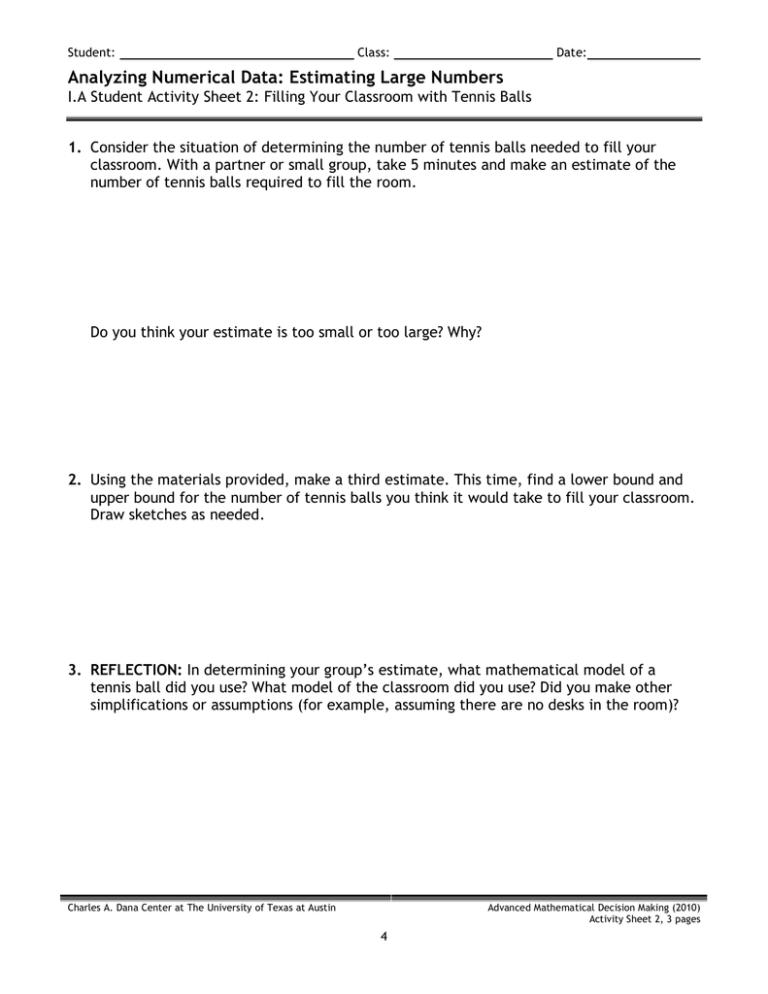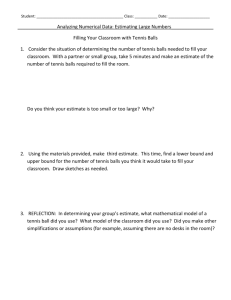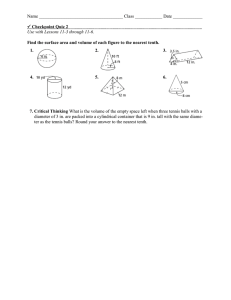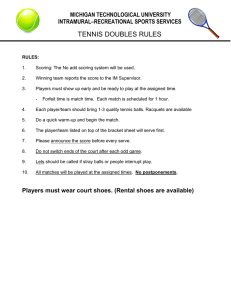1.2 filling your classroom with tennis balls
advertisement

Student: Class: Date: Analyzing Numerical Data: Estimating Large Numbers I.A Student Activity Sheet 2: Filling Your Classroom with Tennis Balls 1. Consider the situation of determining the number of tennis balls needed to fill your classroom. With a partner or small group, take 5 minutes and make an estimate of the number of tennis balls required to fill the room. Do you think your estimate is too small or too large? Why? 2. Using the materials provided, make a third estimate. This time, find a lower bound and upper bound for the number of tennis balls you think it would take to fill your classroom. Draw sketches as needed. 3. REFLECTION: In determining your group’s estimate, what mathematical model of a tennis ball did you use? What model of the classroom did you use? Did you make other simplifications or assumptions (for example, assuming there are no desks in the room)? Charles A. Dana Center at The University of Texas at Austin Advanced Mathematical Decision Making (2010) Activity Sheet 2, 3 pages 4 Student: Class: Date: Analyzing Numerical Data: Estimating Large Numbers I.A Student Activity Sheet 2: Filling Your Classroom with Tennis Balls Fermi Questions “How large is the crowd?” is an example of a Fermi question, which requires estimating physical quantities to produce an answer. Enrico Fermi was an Italian physicist known for his ability to take limited information and arrive at a reasonable numerical estimate. He approached a problem by setting a lower estimate—a value that the item in question was more than—and an upper estimate—a value that the item in question was smaller than. Fermi then worked through the problem using this approach and reached a numerical estimate within identified limits. Fermi worked at the University of Chicago, and his classic question was “How many piano tuners are there in the city of Chicago?” Fermi questions rely on making logical assumptions about a situation to reach an estimate to an order of magnitude (usually a power of 10). That is, the estimate is expressed in hundreds, thousands, millions, and so on—whatever unit is appropriate for the question. Another example of a Fermi question is: Can every person in the world fit inside a cubic mile? What assumptions do you need to make? What information do you need to find? Charles A. Dana Center at The University of Texas at Austin Advanced Mathematical Decision Making (2010) Activity Sheet 2, 3 pages 5 Student: Class: Date: Analyzing Numerical Data: Estimating Large Numbers I.A Student Activity Sheet 2: Filling Your Classroom with Tennis Balls 4. EXTENSION: Tackle one or more of the following Fermi questions: a. Which is more valuable: a pile of pennies equaling your weight or a stack of quarters equaling your height? b. What is your estimate for the total amount of time students in your school spent during this past semester studying for final exams? c. If the land area of Earth was divided equally for each person on the planet, about how much would you get? d. How many songs are played on your favorite radio station in a given year? e. What is your estimate for the number of airline flights in a year? f. What is your estimate for the total number of hairs on your head? g. What is your estimate for the number of square inches of pizza consumed by all students in your school during the past year? h. How many gallons of gasoline do cars use each year in the United States? i. How many hot dogs are eaten at major league baseball games during a season? j. How many minutes will U.S. high school students spend texting on their cell phones during the next year? k. How much does it cost to raise a child? Charles A. Dana Center at The University of Texas at Austin Advanced Mathematical Decision Making (2010) Activity Sheet 2, 3 pages 6



